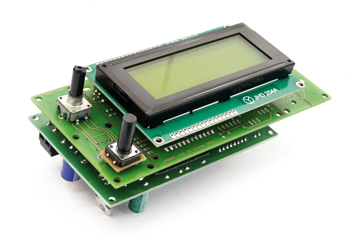Experimenter’s Function Generator
Platino’d for squarewave, sine, sawtooth, noise, and more

This is a MEMBER ONLY article. You need a subscription to read this article.
- Unlimited access to online Member Only articles
- 3 new editions Elektor Magazine (digital)
- More than 5000 Gerber files
- 20% member discount on e-books (at elektor.com)
- 10% member discount on Products (at elektor.com)
Available from €5.33 per month.
What is Members Only
Elektor is committed to providing high-quality content on electronics, catering to tens of thousands of paying members. As part of this commitment, Elektor has launched Premium, an initiative that offers exclusive online articles to members sometimes even before they appear in the magazine.
Every day, members can access in-depth articles that showcase the best of Elektor's premium content.
This initiative aims to reward members with early access. Once logged in, members can easily enjoy this exclusive content and engage in discussions about featured projects. While Premium adds to the existing resources available, Elektor will continue to provide a wealth of free information.
Join the Elektor community today to take advantage of Premium and other benefits!
Gerber file
CAM/CAD data for the PCB referred to in this article is available as a Gerber file. Elektor GREEN and GOLD members can exclusively download these files for free as part of their membership. Gerber files allow a PCB to be produced on an appropriate device available locally, or through an online PCB manufacturing service.
Elektor recommends the Elektor PCB Service service from its business partner Eurocircuits or AISLER as the best services for its own prototypes and volume production.
The use of our Gerber files is provided under a modified Creative Commons license. Creative Commons offers authors, scientists, educators and other creatives the freedom to handle their copyright in a more free way without losing their ownership.
Extra info / Update
ATMEGA1284P microcontroller on Platino board
20 x 4 LCD Display
DC Input: 18–20 VDC
Standard BNC type connectors for outputs / input
Outputs:
1. Clock, max. 10 MHz, 5 V / 3.3 V switchable
2. Sine, Square, Triangular, Sawtooth, Inverted Sawtooth, Pulse, Arbitrary and Random (Noise), max. 100 kHz, max approx. 5 V into 50 Ohm
Input: Frequency Modulation (125 kHz ±50 Hz for SDR)
Controls: rotary encoder control with pushbutton, Back button
Setup Mode for Arbitrary and Clock mode
Normal Mode for other output waveforms
Waveform Amplitude, Frequency, Offset adjustable in real time
One calibration setting
Components
The BOM (Bill of Materials) is the technically exhaustive listing of parts and other hardware items used to produce the working and tested prototype of any Elektor Labs project. The BOM file contains deeper information than the Component List published for the same project in Elektor Magazine. If required the BOM gets updated directly by our lab engineers. As a reader, you can download the list here.
Want to learn more about our BOM list? Read the BOM list article for extra information.
Component list
Signal Generator Board
Default: 5%, 0.25W
R1,R3,R5,R7,R9,R11,R13,R17 = 10kOhm
R2,R4,R6,R8,R10,R12,R14,R15,R16,R18,R19 = 20kOhm
R20 = 100Ohm
R21,R24 = 1kOhm
R22 = 1.8kOhm
R23 = 120Ohm
R25,R26 = 8.2kOhm 3.9kOhm
R27,R28 = 1Ohm 2W
R29,R30 = 10Ohm 68Ohm 1%
P1 = 100kOhm multiturn trimpot, vertical
C1 = 100pF
C2,C4 = 470µF 16V radial
C3,C5,C6,C9 = 100nF radial
C7,C8 = 22µF 25V radial
C10,C11 = 1000µF 63V 35V radial
C12 = 470µF 35V radial
IC1 = TL082ACP
IC2 = (CD)74HC4051
IC3 = LM337KCSE3
IC4 = MC7805
IC5 = LM317TG
IC6 = LM336BZ-5.0
D1 = BY500-800-E3/4
D2 = BZX79-C5V1
D3,D4 = 1N4007
K1 = 10-way pinheader socket strip, SIL, straight
K2 = 8-way pinheader socket strip, SIL, straight
K3 = 12-way pinheader socket strip, SIL, straight
K4 = 6-way (2x3) pinheader socket, double row
K5,K6,K7 = 2-way pinheader, vertical, 0.1” pitch
K8 = 2-way PCB screw terminal block, 0.2” pitch
IC socket, DIP-16
IC socket, DIP-8
PCB no. 130407-1
Platino Configuration*
Resistors
Default: 5% 0.25W
R3 = 47Ohm
R4,R5,R6,R7,R10,R12 = 10kOhm
R11 = 4.7kOhm
P1 = 10kOhm, trimpot, horizontal
Capacitors
C1,C2 = 22pF, 50V, C0G/NP0, 0.1” pitch
C5,C6 = 100nF, 50V, X7R, 0.2” pitch
Semiconductors
IC1 = ATMEGA1284P-PU, programmed
T1 = BC547C
Inductors
L1 = 10µH
Miscellaneous
IC socket, DIP-40
LCD1 = LCD, 4x20, 5V, with backlight
S5A = rotary encoder with pushbutton
X1 = 20MHz quartz crystal, CL= 18pF
K1,K2,K5 = 40-pin SIL pinheader, vertical
K4 = 80-pin double-row pinheader, vertical
K9 = 36-way pinheader receptacle (socket), SIL, vertical
S4A = pushbutton
*Please refer to ref. [3] for full description of Platino.






Discussion (0 comments)